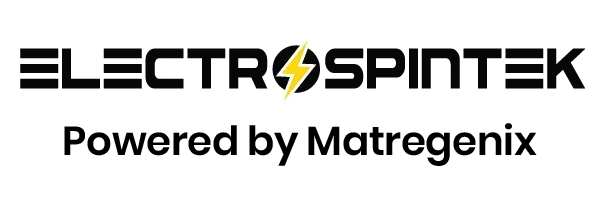FAQs
The answers you need. The clarity you want. All in our FAQs
What is electrospinning?
- Electrospinning is a technique that uses high voltage to produce ultrafine fibers from polymer solutions or melts. It’s widely used for fabricating nanofiber materials with high surface area and porosity.
What are the typical applications of electrospinning?
Electrospun nanofibers are used in diverse fields:
- Biomedical: tissue engineering, wound healing, drug delivery
- Filtration: air, water, and industrial filters
- Energy: battery separators, fuel cells
- Textiles: smart fabrics, protective clothing
- Cosmetics & skincare: nanofiber masks, controlled release systems.
Can I adjust the nanofiber diameter?
Yes. Fiber diameter can be tuned by adjusting parameters such as:
- Polymer concentration and viscosity
- Voltage
- Flow rate
- Spinneret-collector distance
- Environmental conditions (temperature & humidity)
Can I electrospin different types of materials?
Yes. We support a wide range of natural and synthetic polymers, including:
- PCL, PLA, PLGA, PAN, PVDF, Gelatin, Chitosan, Collagen, and more
- We also work with water-based, solvent-based, and hybrid systems.
Can I electrospin two different polymers simultaneously?
Yes. You can produce blended nanofibers or separate fiber layers using dual-nozzle configurations or multi-syringe setups, available on our advanced machines like the LS-325 and ES800H4.
How can I produce bicomponent nanofibers (core-shell)?
Our machines support coaxial electrospinning, where two polymer solutions are fed through a specialized coaxial nozzle to create core-shell (bicomponent) fibers. This is useful for drug encapsulation, barrier layers, or combining properties of two polymers.
Electrospinning
What are the advantages of nanofibers?
Nanofibers offer:
- High surface area-to-volume ratio
- Excellent tunability and porosity
- Capability to mimic extracellular matrices (biomedical)
- Versatility in mechanical and functional properties
Can I align nanofibers or make specific patterns?
Yes. Our systems offer various collectors (rotating drums, patterned electrodes, etc.) to control fiber alignment, thickness, and structure.
Can ElectrospinTek produce nanofiber samples for us?
Yes. We offer contract manufacturing and R&D services, including custom nanofiber membranes, scaffolds, and coatings tailored to your application.Electrospinning Machines (ElectrospinTek Systems)
What electrospinning systems does ElectrospinTek offer?
Yes. You can produce blended nanofibers or separate fiber layers using dual-nozzle configurations or multi-syringe setups, available on our advanced machines like the LS-325 and ES800H4.
- LS-200: Compact, lab-scale unit for entry-level research
- LS-325: Advanced lab unit with dual-syringe capability, controlled atmosphere, and multiple collectors
- ES800H4: Industrial system with roll-to-roll collection, needle-based and needleless platforms, customizable widths (55–150 cm)
Can I switch between needle-based and needleless electrospinning?
Yes. The ES800H4 comes with interchangeable platforms that allow for both methods, giving you flexibility based on your throughput and material requirements.
What’s the production speed of your industrial system?
The ES800H4 supports production speeds up to 25 meters per minute, depending on polymer type and desired basis weight.
Do you offer support after purchase?
Absolutely. We provide:
- On-site installation and training
- Remote troubleshooting and technical support
- Process optimization for specific materials
- Ongoing R&D collaboration if needed
Can you help scale up from lab to production?
Yes. Many clients start with our lab units (LS-200 or LS-325) for R&D and then scale up to the ES800H4 for pilot or full-scale production.
Nanofibers
Does the machine have a drum collector?
Yes both the LS200 and LS325 have a rotating drum collector and a flat collector
How can we connect the machine in our lab?
The machines are plug & play systems. They need to be connected to electricity, grounding and ventilation.
Is this suitable with coaxial?
Yes both the LS200 and LS325 are compatible with coaxial systems.
How can we ensure uniform coating?
The machines are equipped with a homogeneity system, in which the nozzles are moving in x-axis to produce a homogeneous membrane.
Can I use commercial needles?
Yes it is possible to use commercial needles.
How are your nozzles different from commercial needles?
The design of our nozzles optimizes the throughput, and helps to overcome clogging of the polymer solution in the tip of the nozzle.
What range of humidity & temperature can we control?
Down to 30% – and Temperature up to 40°C.
